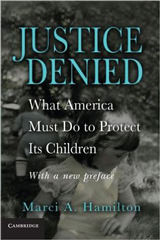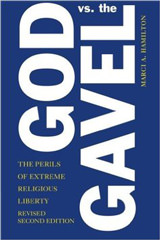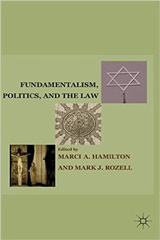On this Wednesday, January 22d, the Supreme Court heard oral argument in Paroline v. Unknown Amy, which involves the question of how much child pornography market participants should be individually required to pay for the harm to the subjects of the videos.
The Law
Over thirty years ago, the Supreme Court also considered the issue of child pornography, in New York v. Ferber, which involved the question whether the First Amendment protected a bookstore proprietor who was convicted under New York law for distributing child pornography. The Court had previously ruled that obscene materials, as defined under Miller v. California, were unprotected by the First Amendment. Ferber argued that if the materials were not obscene, then he should have a First Amendment defense to the distribution. The Ferber Court rejected his arguments, and ruled that even if the child pornography at issue was not obscene, such pornography is so harmful to children that there is no First Amendment protection for its distribution.
With the wide distribution of the personal computer, and the feverish growth of the Internet in the decades since, the marketplace for child pornography has exploded. The 1982 Ferber Court was prescient, as it already understood then what we now know for a fact: if we are going to protect children from being harmed by child pornography, it is not enough to go after the people who produce it. Its distribution and possession must also be penalized. Thus, the Court held as follows:
“While the production of pornographic materials is a low profile, clandestine industry, the need to market the resulting products requires a visible apparatus of distribution. The most expeditious, if not the only practical, method of law enforcement may be to dry up the market for this material by imposing severe criminal penalties on persons selling, advertising, or otherwise promoting the product.”
The law is always trying to catch up to social reality, and that is no more true than it is with Congress’s attempts to halt child pornography. Since the Internet and its potential for crime was apparent, Congress has frequently revisited the issue of halting child pornography, with uneven success. While the Supreme Court has not retreated from the core holding in Ferber, it has made shutting down the marketplace more difficult with its child pornography holdings in a series of cases, including United States v. American Library Assn. and Free Speech Coalition v. Gonzales. The bottom line of this set of cases is that the First Amendment is a defense if the viewer views images that do not involve real children, but not, as in Ferber, if the pornography involves actual children. Had the government been able to outlaw images of child pornography, per se, it would have had a powerful tool to shut down the market with evidence solely of the images themselves. Instead, however, authorities must prove that the images are in fact real children or, if virtual in appearance, derived from specific, real children, as opposed to adults who look like, or who are made to look like, children, or virtual images divorced from actual children. That means that we will not be able to “dry up” the market, as the Court suggested is needed in Ferber. But we certainly can attack the market, and that is what the statute in this case is attempting to do.
Two things are clear. First, to undermine the market, we need to penalize the viewers and possessors of the actual child pornography, as well as the producers and distributors. Second, victims of child pornography deserve restitution for the harm done to them by the operation of this ugly marketplace. Between those two principles, Congress enacted the Mandatory Restitution for Sexual Exploitation of Children Act, which is the law at issue before the Court in Paroline v. Unknown Amy.
Paroline possessed two images of “Amy,” whose images of being raped by her uncle at ages 8 and 9 are considered the most widely disseminated child pornography images worldwide. It should go without saying that the rapes were horrific, but thankfully, Amy was able to recover and even entered college.
Amy did not know that the rapes were videotaped until she was in her late teens. That revelation devastated her, and has led to terrible consequences, including her dropping out of school, being haunted by a fear that anyone she meets may have seen her being raped as a child, and a host of other severe problems. The estimated total cost of the harm that was done to her, leading to her need for lifelong medical and therapeutic support, comes to about $3.2 million. Under the Restitution Act, Amy’s lawyer, Univ. of Utah Law Professor Paul Cassell, argued to the Justices that anyone who was a possessor, a distributor, or a maker of the pornography—should be liable for all of the damages Amy suffered, without the need for a showing regarding how any particular market participant directly harmed her, and that that was Congress’s intention.
Professor Cassell, along with lawyer James Marsh, have pursued many in this illegal marketplace on Amy’s behalf, and she has obtained between $1 million and $2 million so far. For them, the enemy is the market itself, and so it makes little sense to apportion damages differently according to the role that was played by a given market participant, or to burden the victim with having to prove how this perpetrator registered this harm.
In opposition, Stanley Schneider, the lawyer for Petitioner, a man named Doyle Randall Paroline, argued that it was unfair for Paroline to be held responsible for all of the harm the images of Amy wrought, given that he himself had only possessed two images, out of the many thousands, if not millions, that were distributed on the Internet. Mr. Schneider argued that Amy should have to prove that Paroline was a proximate cause of her harm, which he assumed she could not do, and, therefore, that he should not be required to pay any damages.
Deputy Solicitor General Michael Dreeben argued for a middle ground, where a defendant like Paroline could not be held responsible for all of the harm. To the Justices’ frustration, however, Solicitor Dreeben was unable to provide a bright-line rule to cabin his theory. Rather, he simply suggested that the courts should have discretion to craft such damages remedies.
The Justices found Paroline’s arguments the least persuasive, but they were torn between the arguments presented by the victim’s attorney (whoever gets caught can be on the line for the full amount) and those presented by the government (there needs to be some correlation between the harm that is done by the perpetrator and how much money the perpetrator pays).
The Science of Child Sex Abuse that Informs Congress and the Court About Who Should Pay for Child Pornography
The first question that needs to be addressed here, perhaps, is whether we should hold viewers or possessors of child pornography liable at all. Some might think that the viewer/possessor is engaged in a no-harm, no-foul act, and that the truly bad people are the creators and the active distributors. How has an anonymous viewer hurt a particular victim? The answer is: Plenty, even if it is difficult to prove.
Social scientists have been studying child sex abuse and child pornography for decades now, and a great deal of data is now available to help explain and clarify the actual harm that is done to a victim. In this case, I wrote an amicus brief for APSAC (the American Professional Society on the Abuse of Children), in which we gathered the best science to date on the harm that is done to child pornography victims.
Here are a few of the most important facts. First, as everyone knows, child sex abuse (whether the child is involved in pornography or not) can produce many negative effects on its victims.
Second, photoshopping or other technological tricks can create victims out of children who were never sexually abused in the real world. A child whose image is included in child pornography, but who was not sexually abused, can still be deeply traumatized by the images of his or her sexual abuse imagery. While one might never think about this possibility, once the point is made, it is actually obvious. Anyone would be upset about a picture of them being sexually assaulted, whether it actually happened or not, and they would also be haunted by the possibility that others would see it. Thus, the harm of child sex abuse is, in fact, a separate harm from the harm of having an image captured and distributed of oneself in which one only appears to be engaged in sex acts.
Third, the harm of child pornography to the subject is not simply the harm of knowing that the image is “out there.” Rather, victims experience child pornography as a series of independent events, where each time a person views an image, or distributes it, he or she, the victim, feels violated. For the victim, therefore, 8,000 views feels like 8,000 injuries, not a single injury. Justice Scalia, as well as the other Justices, fundamentally understood the plight of Amy, who herself was present at the Supreme Court argument: “The woman has undergone serious psychological harm because of her knowledge that there are thousands of people out there viewing her rape.” Later, Justice Scalia added, “Each person increases the amount of her psychological harm.”
Fourth, for the child who is sexually abused as part of the child pornography, the pornography exacerbates the negative effects of the abuse. It is a separate harm. And victims typically need damages to cover the costs to their health and careers for the rest of their lives.
These very serious harms, and the cost to the victim, logically lead to the conclusion that the pornography market as a whole, and its individual participants, should be responsible for restitution. The simple truth is that the market would not operate without three constituencies—creators, distributors, and viewers—and so it follows that whoever is caught is the one who is responsible for the restitution. As the Supreme Court said in Ferber, what we need to do is to dry up the market. Those in the market are all co-conspirators in the victim’s harm.
Where Is the Limiting Principle?
The problem for the Justices was not that Amy would be able to recover for the full value of the harm done to her, or that the harm is so significant. Rather, as Justice Breyer put it, the problem is that there needs to be “some limiting principle.” This is a natural judicial, legal system response, and should have come as no surprise to anyone.
One possible limiting principle is that the restitution is for the actual harm done, and not for punitive damages. Thus, once the victim has obtained the full amount of what her doctors and career advisors say she has lost and will lose in the future, it is over for her. The more that the first perpetrators caught can pay, the faster Amy can return to her life.
Even if the restitution portion of her justice is then over for Amy, it is not yet over for the porn market participants. Conceivably, a perpetrator who pays early and in a large amount may well go after others in the marketplace, now or later, to force them to pay a share, on a theory of contributory liability. If that is not possible under the federal statute, it should be. Moreover, doesn’t this system also increase the likelihood that a perpetrator at any point in the chain will be more likely to point to other participants so as to spread the pain of the restitution? If that happens, it is a good outcome for everyone.
Another limiting principle was pointed out by Jeff Dion, the Director of the National Crime Victim Bar Association, who says, “Many victims of child pornography have no idea that they may be entitled to restitution and that an attorney can help them bring a civil action.” Moreover, many will choose not to bring such claims, or will be emotionally or otherwise incapable of participating in the judicial system. Therefore, we need the ones who do come forward to inflict as much pain as possible on the targets that the authorities find, to send a strong message of deterrence to the marketplace.
Perhaps the most important limiting principle in terms of the Paroline case’s outcome is that the Justices are interpreting a federal statute, not creating the law out of whole cloth. Barring a constitutional violation, they thus must defer to the plain language of the statute and its legislative history, which, as Professor Cassell asserted, does seem to say that the victim does not have to show that a perpetrator was a “proximate cause” of particular harm, and that any one perpetrator may well be liable for the full restitution. In the absence of a proximate cause requirement, Amy should win, and Paroline should pay.
(Of course, courts can order perpetrators to pay, but they will only be able to pay what they have, so an order to pay full restitution is really only as good as the perpetrator’s holdings, and may necessitate further prosecutions in order to make the victim whole.)
The Court certainly can criticize Congress for creating a cumbersome system, but changing the parameters of the restitution system is a matter that is best left to Congress, not the Court. I have no doubt that Congress is ready and willing to return to the drawing board if there are better paths. They should be particularly motivated after hearing about the latest and most depraved development yet: Twenty-nine men were arrested last week for operating webcams streaming live, online, child sex abuse.










“Rather, victims experience child pornography as a series of independent events, where each time a person views an image, or distributes it, he or she, the victim, feels violated. For the victim, therefore, 8,000 views feels like 8,000 injuries, not a single injury.”
Do you have a lead up your rear end? The way it is stated makes it sound like voodoo. If viewing is all it takes to instantaneously hurt the victim then why is the FBI not being held accountable? or ICE? or NCMEC? or IWF? They view images of children being raped all the time, but you choose to hold everyone else “responsible” for the victims “injuries”? The judges are idiots and the AGs are idiots, both belong in a barrel floating down the Niagara Falls.
All of this hysteria is just to allow the feds to keep their jobs and fund their project to “protect children”.
“Rather, victims experience child pornography as a series of independent events, where each time a person views an image, or distributes it, he or she, the victim, feels violated. For the victim, therefore, 8,000 views feels like 8,000 injuries, not a single injury.”
Do you have a lead up your rear end? The way it is stated makes it sound like voodoo. If viewing is all it takes to instantaneously hurt the victim then why is the FBI not being held accountable? or ICE? or NCMEC? or IWF? They view images of children being raped all the time, but you choose to hold everyone else “responsible” for the victims “injuries”? The judges are idiots and the AGs are idiots, both belong in a barrel floating down the Niagara Falls.
All of this hysteria is just to allow the feds to keep their jobs and fund their project to “protect children”.
The one judge who said that the knowledge of people looking at her images is what victimizes her, not when an anonymous viewer in Crotia is looking at her images. She must be notified in order to be victimized. Why are people not using common sense when writing such articles. I understand the victim was hurt as a child, but bending this any further will just cause any sympathy left to fall apart. At the moment the victim only sounds like a money hungry individual whose victim impact statement was written by Dr. Joyanna Silberg.
So many people are suckered into this child pornography restitution scam. No one deserves restitution UNLESS they were hurt directly. Every action has a reaction. If you notify Amy that Defendant Joe was arrested she is victimized, if Amy is not notified about any Defendant how is she victimized now? She is not!